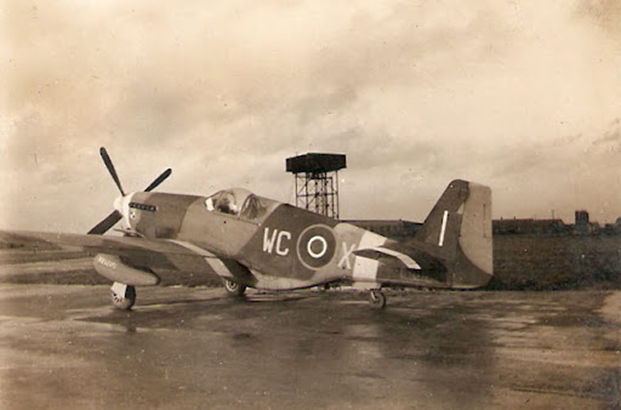
Added to cart


Arrived at RAF Bradwell Bay
15/04/1942
Departed RAF Bradwell Bay
15/03/1943
Aircraft Flown at Bradwell Bay
Boston lll Havoc
Squadron Code TH
418 Was a relatively newly formed squadron of the Royal Canadian Airforce. They had formed at RAF Debden but were scheduled to move to RAF Bradwell Bay which was in the finishing stages of construction.
They moved into RAF Bradwell on 15th April 1942 and were the longest serving squadron at Bradwell. They left to go to Ford on 15th March 1943. The first operational flight from RAF Bradwell Bay was on 16th April 1942, when a crew of three took off at 2154 for an intruder raid to Gilze Rijen airfield in the Netherlands – intruder raids were the main work of 418 Squadron.
The squadron was very much linked in personnel and experience with 23 Squadron. Being the longest serving squadron at Bradwell Bay and due to the dangerous nature of intruder raids the squadron lost a high number of aircrew.
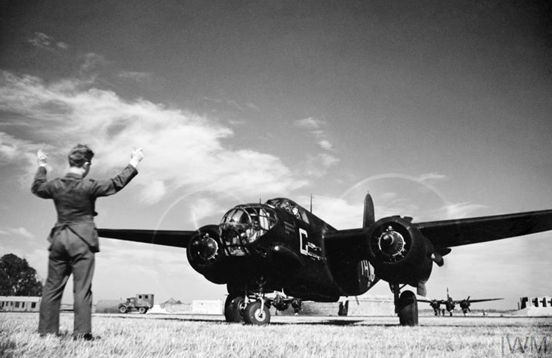
© IWM CH 7210
Arrived at RAF Bradwell Bay
14/08/1942 (Detachment)
3/10/1942
Departed RAF Bradwell Bay
21/08/1942
27/12/1942
Aircraft Flown at Bradwell Bay
Boston Havoc 1
Mosquito ll
Squadron Code YP
Linked with 418 in terms of aircrew and aircraft, 23 squadron moved to RAF Bradwell Bay initially as a detachment from Ford until the whole squadron moved in with Boston Havoc aircraft before converting to Mosquitoes. Carrying out intruder missions before being posted just after Christmas to Malta. The siege of Malta had just finished and 23 Squadron provided relief cover.
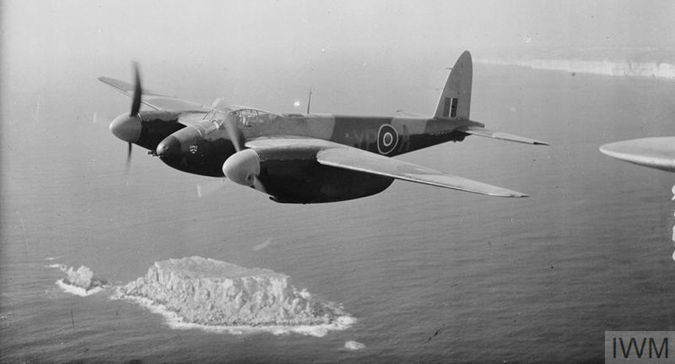
© IWM (CM 4766)
Arrived at RAF Bradwell Bay
15/03/1943
Departed RAF Bradwell Bay
13/05/1943
Aircraft Flown at Bradwell Bay
Mosquito ll
Squadron Code RS
157 arrived at Bradwell Bay on the day that 418 Squadron moved out. Reformed in 1941 as a night fighter squadron at RAF Debden. The squadron came to Bradwell Bay from Castle Camps. Their role was to fly defensive patrols and also ‘Ranger’ operations which were intruder missions to the near continent but with freedom to select and attack targets.
Their time at Bradwell Bay was quite short, only 2 months. During this time, they lost a Flight Commander, S/L Viscount Clive and P/O Eastwood in a training accident close to Manningtree in North Essex.
In mid-May the squadron moved on to Hunsdon.
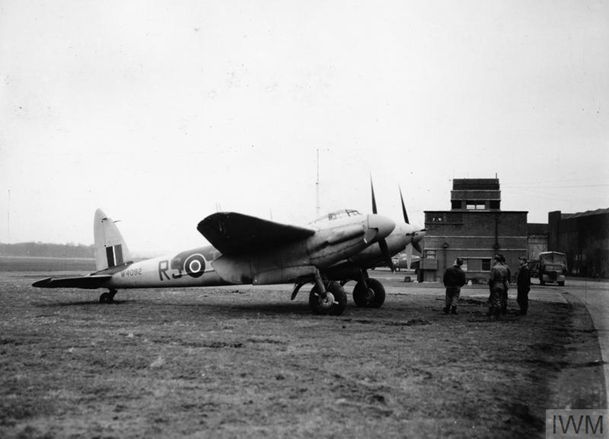
© IWM (HU 93019)
Arrived at RAF Bradwell Bay
13/05/1943
Departed RAF Bradwell Bay
03/09/1943
Aircraft Flown at Bradwell Bay
Beaufighter VlF
Mosquito Xll
Squadron Code RO
29 Squadron arrived at Bradwell Bay, from West Malling, as a night fighter squadron, initially flying Beaufighter’s but soon to convert to Mosquitoes. The squadron were impressed with the facilities at RAF Bradwell Bay. On 17th May representatives from the makers came down to Bradwell Bay, including Mr. Peter de Havilland, to discuss the handling aspects of the Mosquito aeroplane. Defensive patrols were carried out using the Beaufighters until the conversion to Mosquitoes took place by the end of May. From this time operations were carried out by a mixture of both aircraft types. There were some problems with the mosquito aircraft, being mostly new. These ‘teething problems’ were soon sorted out by the manufacturers. The squadrons next move was to RAF Ford.

© IWM (CH 14640)
Arrived at RAF Bradwell Bay
04/06/1943
Departed RAF Bradwell Bay
10/07/1943
Aircraft Flown at Bradwell Bay
Typhoon lB
Squadron Code ZY
During the early part of the war 247 protected the West country using Hurricanes. In January 1943 the Squadron had converted to the Hawker Typhoon, designed as a replacement for the Hurricane. Prior to being posted to RAF Bradwell Bay the Squadron was based at RAF Gravesend. The moved to Bradwell seemed an organised chaos but the squadron was quite pleased with the facilities at Bradwell. However, their tenure at Bradwell was short, only about 5 weeks before being moved again to New Romney.
Plans for the invasion of Europe were being made at this time, although the crews would have been unaware of it. 247 Squadron was to become part of 2 TAF (Tactical Air Force) as the Typhoon was suited towards the ground attack role and so would have part of the army co-operation role planned for the invasion.
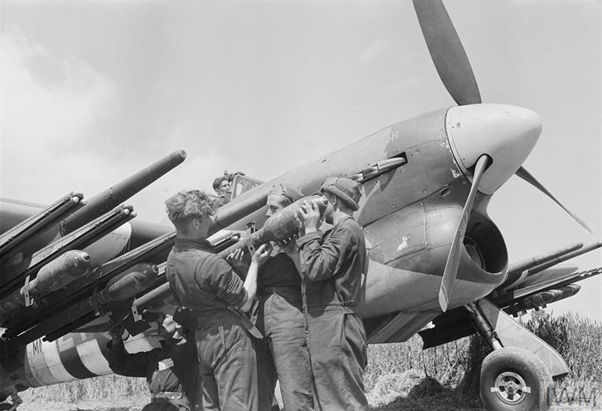
© IWM (CL 157)
Arrived at RAF Bradwell Bay
23/08/1943
Departed RAF Bradwell Bay
04/10/1943
Aircraft Flown at Bradwell Bay
Typhoon lB
Squadron Code US
Another squadron moving in with Typhoon 1B aircraft. The Typhoon was designed as a replacement for the Hurricane and was under design and development from the beginning of the war. There were many teething problems, especially with the development of the Sabre engine. Some of the Typhoon problems were fatal. It wasn’t until late in 1942 that the problems began to be rectified. In 1943 the ground attack role was recognised as the key use of the Typhoon.
56 Squadron came to Bradwell Bay late in August 1943 from Manston, they had been based at Martlesham and Manston for some time. While at Bradwell Bay the squadron carried out training and a few patrols, Including an air sea rescue patrol. One problem they did experience was tyres bursting both on take off and landing. No major injuries were incurred.
The squadron was destined to become part of 2 TAF and potentially go to Europe following the Normandy invasion. From Bradwell Bay they returned to RAF Martlesham.

© (IWM FLM 1480)
Arrived at RAF Bradwell Bay
19/08/1943
Departed RAF Bradwell Bay
25/08/1943
Aircraft Flown at Bradwell Bay
Typhoon lB
Squadron Code TP
Almost a visitor rather than a based squadron, spending only1 week at Bradwell Bay. The squadron's initial fears were found to be justified of Bradwell Bay being very isolated. Their workload was mainly in patrols including a couple of ‘Rhubarb’ intruder missions.
The squadron were then posted to Manston to replace 56 Squadron, who were ‘Livid’ at being replaced there.

© IWM (CH 20542)
Arrived at RAF Bradwell Bay
03/09/1943
Departed RAF Bradwell Bay
03/05/1944
Aircraft Flown at Bradwell Bay
Mosquito Xll
Mosquito Xlll
Squadron Code ME
A squadron of the Royal New Zealand Airforce and one of Bradwell Bay’s longer serving squadrons. One of two Mosquito Squadrons to move in during the Autumn of 1943. The 2 squadrons were moved to Bradwell Bay as part of the preparations for the Normandy invasion planned for the following year.
At the time of their move to Bradwell Bay they were a defensive squadron and had moved from RAF Drem in Scotland. They were active on home defence especially during Operation Steinbock, known as the ’Baby Blitz’, in early 1944. On 21st March 1944 the squadron bought down 3 aircraft in 1 night, 2 by the same crew.
In the spring of 1944, a separate airfield administration called 150 airfield was established at Bradwell Bay. This provided training for being a mobile force and personnel had to live in tents. So, the crews had to leave the relative comfort of the officer’s mess in Bradwell Lodge to ‘roughing’ it in tents.
488 were planned to be a part of 150 Wing and indeed moved into the tented camp. There was a change of plan for 488 when they were directed initially to RAF Colerne on 3rd May 1944. This was only a short stay as on 12th May they were transferred to Zeals in Wiltshire.
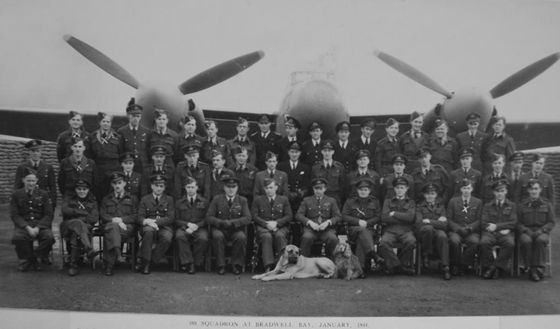
Arrived at RAF Bradwell Bay
06/10/1943
Departed RAF Bradwell Bay
07/04/1944
Aircraft Flown at Bradwell Bay
Mosquito Vl
Squadron Code UP
605 Squadron shared RAF Bradwell Bay with 488 Squadron. They were to spend 6 months at Bradwell Bay. Their role was complimentary to 488. 605 squadron's role was that of intruder raids to soften up the defences on the continent prior to the Normandy invasion, while 488’s role was more home defence. 605 was not a part of the 150 Airfield (later 150 Wing) and so did not have to live in the tented camp.
605 moved into Bradwell Bay on 6th October, their Operational record book states for 6th October: CASTLE CAMPS – BRADWELL BAY. The move was completed by 1400 hours. Squadron HQ and the Ops room are in East Wick House, a very pleasant old farmhouse, but wall space is a bit of a problem. The Station Commander is all out to make life comfortable, and to get things arranged to our liking, as is everybody on the Station.
605 did not waste any time and were active doing intruder raids from 7th October.
The squadron moved to RAF Manston on 7th April to be nearer to the coast for the Normandy invasion.
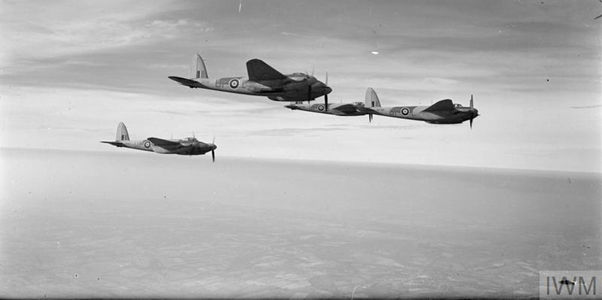
© IWM CH 9475
Arrived at RAF Bradwell Bay
06/03/1944
Departed RAF Bradwell Bay
28/04/1944
Aircraft Flown at Bradwell Bay
Tempest V
Squadron Code JF
Another short-term visitor, very much a move with the Normandy invasion in mind. On arrival at Bradwell Bay the squadron was transitioning to the Tempest V. On 7th April the squadron flew to RAF Ayr (Heathfield) near Glasgow. This was for a armament practice course which included ground crew as well as aircrew. They left Ayr on 14th April and returned to Bradwell.
The station commander Wing Commander R.F. (Digger) Aitken had been the squadron commander of 3 Squadron and was to go on to run 150 Airfield which was the tented camp being prepared at RAF Bradwell Bay to acclimatise squadrons to be part of a mobile tactical Airforce for what was anticipated to be a mobile war once France had been invaded at Normandy.
3 Squadron left Bradwell Bay on 28th April to go to the Advanced Landing Ground at Newchurch in Kent where they remained until 21st September 1944. Providing cover for the D Day Landings.
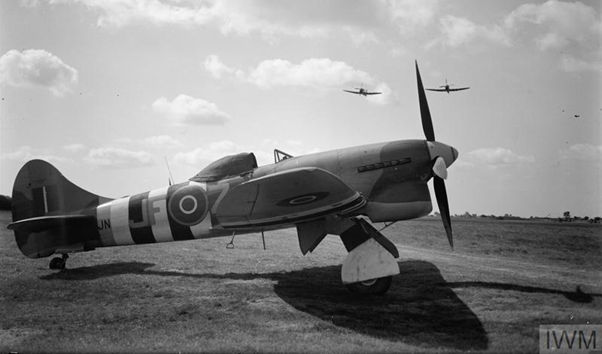
© IWM (CH 14095)
Arrived at RAF Bradwell Bay
01/04/1944
Departed RAF Bradwell Bay
29/08/1944
Aircraft Flown at Bradwell Bay
Mosquito XXX
Squadron Code FK
Arriving at Bradwell Bay on April Fool’s Day 219 were destined to remain there over the invasion period. Although they were aware the invasion was imminent the did not know exactly when, until 5th June they were informed by W/Cdr Boyd.
219 ORB 05/06/1944
Eleven crews flew on NFT’s during the day, and at 2200 hours all the crews on duty assembled at “A” Flight and were informed by W/Cdr BOYD that “D” Day was the next morning. Great excitement and keenness was displayed and 9 patrols were carried out at night but nothing untoward occurred.
Patrols carried out protecting shipping during the invasion were uneventful. The Luftwaffe famously did not provide much defence against the invasion.
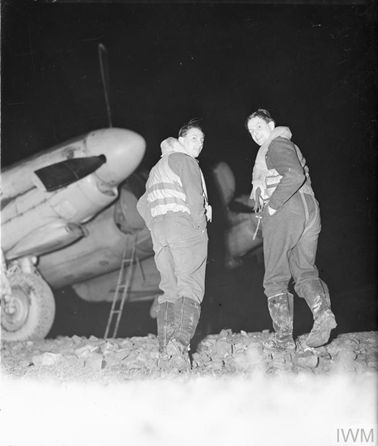
© IWM CL 2029
Arrived at RAF Bradwell Bay
21/04/1944
Departed RAF Bradwell Bay
27/09/1944
Aircraft Flown at Bradwell Bay
Anson l
Airspeed Oxford
Spitfire VB
Warwick 1
Squadron Code MY
Air Sea Rescue sections had not really developed by the RAF until 1941, and even then, the service was quite sparse. RAF Bradwell Bay was reliant on the Navy for rescue launches from St Osyth and Brightlingsea.
With the anticipated Normandy Invasion Air Sea Rescue cover was revised, in terms of ASR Air cover 278 Squadron moved to Bradwell Bay, in fact it was one flight, ‘A’ flight that moved to Bradwell Bay. ‘B’ flight was based at Martlesham, where they had the amphibious Walrus Aircraft.
The movement of ASR aircraft was to provide wider coverage for the forthcoming Normandy Invasion. On D Day itself there were 4 patrols flown from early morning in Warwick aircraft from Bradwell Bay until late evening. Flying over the Channel Islands and general invasion area. The Anson also patrolled for about 5 hours.
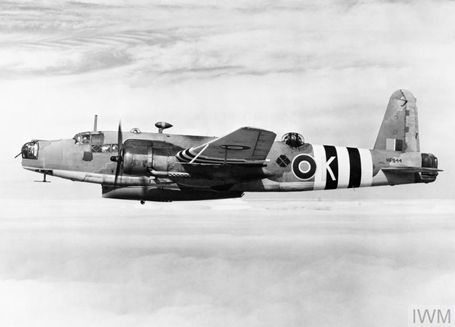
IWM (MH 5337)
Arrived at RAF Bradwell Bay
23/04/1944
Departed RAF Bradwell Bay
26/07/1944
Aircraft Flown at Bradwell Bay
Spitfire Vll
Squadron Code ON
124 Squadron moved into Bradwell Bay on 23rd April 1944 from Church Fenton in North Yorkshire. This was part of the moving squadrons closer to the invasion site. Their aircraft was the Spitfire Vll that was designated as a high-altitude aircraft which had a pressurised cabin. They operated from Bradwell Bay over the invasion period. On 6th June the Squadron Orb on D Day states:
“D” DAY dawns. Squadron full of expectation, but as the day wears on and as the patrols come back one after another with “nothing to report” we realise that, as far as we are concerned at any rate, it is not our “D” Day. 17 uneventful patrols were flown, including one by the Wing Commander Flying, and one by the C.O.
The squadron flew 33 patrols from 05.20 with the last aircraft landing at 22.05. All patrols were recorded as uneventful

© IWM ATP 10976C
Arrived at RAF Bradwell Bay
31/07/1944 (Det)
Departed RAF Bradwell Bay
17/10/1944
Aircraft Flown at Bradwell Bay
Mosquito XVll
Squadron Code VA
The Bradwell Bay contingent of 125 squadron was a detachment from the main Squadron base at Middle Wallop, Bradwell Aircraft were initially flying defensive patrols and Anti-Diver missions.
It was to be in September 1944 when Operation Market Garden was put into place. This difficult operation was supported by aircraft from RAF Bradwell Bay including 125 Squadron Mosquitos.
Defensive patrols were continued from Bradwell Bay until 17th October when the whole squadron was moved from Middle Wallop and Bradwell Bay to RAF Coltishall.

Arrived at RAF Bradwell Bay
30/08/1944
Departed RAF Bradwell Bay
29/12/1944
Aircraft Flown at Bradwell Bay
Spitfire lXB
Mustang lll
Squadron Code SH
A very active squadron reformed in 1936 from a WW1 Squadron. The squadron was active throughout the war including Dunkirk and the Battle of Britain. Also active during the Normandy Landings. Arriving at RAF Bradwell Bay at the end of August initially with Spitfire lXB but converting to Mustang lll in November 1944.
Their work at Bradwell Bay was in strafing raids to assist the allies progress through France and escorting bomber aircraft.
64 Squadron had moved into RAF Bradwell bay on the same day as 126 Squadron, both squadrons departed on 29th and 30th December, both squadrons going to RAF Bentwaters.
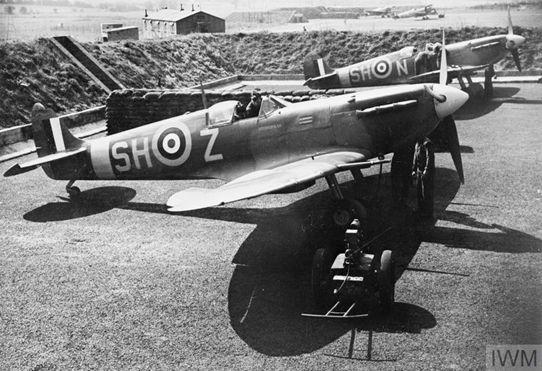
IWM (CH 5756)
Arrived at RAF Bradwell Bay
30/08/1944 15/09/1945
Departed RAF Bradwell Bay
30/12/1944
05/10/1945
Aircraft Flown at Bradwell Bay
Spitfire lXB
Mustang lll
Squadron Code 5J
126 Squadron spent two periods at RAF Bradwell Bay, the first being actively in the post invasion period, the second being post war.
Moving into Bradwell Bay on 30th August the squadron were into action the next day, as the Orb entry states:
1400/ 1625 W/C BIRD-WILSON led Squadron of 9 a/c with S/Ldr PLAGIS leading one section of 3 a/c sweeping the DEXMUDE- LILLE area. 7 locos were damaged, along with 32 R.R. wagons damaged, 2 MET destroyed, 8 MET damaged.
During the 4 months 126 squadron spent at Bradwell Bay they were extremely active over the Continent. On 11th December the squadron was named the Persian Gulf Squadron by Lady Fowle, the whole squadron and echelon were on parade, with the AOC 11 Group attending.
Just after Christmas on 28th December the squadron moved to RAF Bentwaters.
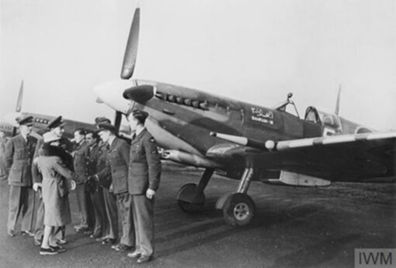
© IWM HU 86321
Arrived at RAF Bradwell Bay
30/08/1944
Departed RAF Bradwell Bay
03/10/1944
Aircraft Flown at Bradwell Bay
Spitfire lX
Squadron Code FY
After moving to Bradwell Bay on 30th August (the same day as 126 Squadron and 64 squadrons) they were also in action the following day with offensive patrols over the Calais area. The squadron carried out offensive patrols over the continent as well as long range escort missions to bombers en-route to bomb Germany.
On 3rd October the squadron was posted to SKEA BRAE in The Orkneys.
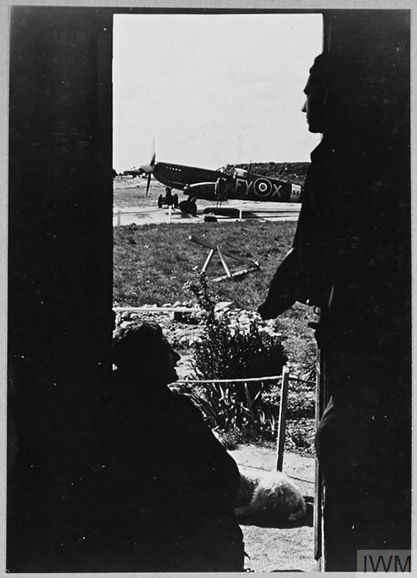
© IWM (CH 9451)
Arrived at RAF Bradwell Bay
22/09/1944
Departed RAF Bradwell Bay
03/03/1945
Aircraft Flown at Bradwell Bay
Tempest V
Squadron Code SD
Tempest V’s came to Bradwell for a 2nd visit, this time with 501 Squadron, and were to stay for almost 6 months.
The main work of 501 Squadron was flying operational patrols from RAF Bradwell Bay, including a few scrambles. Most of the patrols were called anti-diver patrols.
The Germans were carrying out last ditch reprisals with the Vengeance weapons known as the V1 and V2, which started just a few days after the invasion of Normandy started on d Day.
501 Squadrons role was to try to shoot down the V weapons enroute over England.
RAF Bradwell Bay did get hit by a V2 in January 1945 which put Runway 2 out of action.

© IWM CH 2825
Arrived at RAF Bradwell Bay
03/10/1944
Departed RAF Bradwell Bay
27/02/1945
Aircraft Flown at Bradwell Bay
Spitfire HF lX
Squadron Code DU
312 squadron was formed at Duxford on 29 August 1940. Made up mostly of escaped Czechoslovak pilots. 312 came to Bradwell Bay at the beginning of October 1944 as a very experienced squadron flying Spitfires. The Spitfire HF Mk IX was powered by the specialised high-altitude Merlin 70 and entered service in the spring of 1944.
The main role of the squadron during its 5 months based at Bradwell Bay was escorting bombing raids into Germany. On 27th February 1945 the squadron moved to RAF Manston.
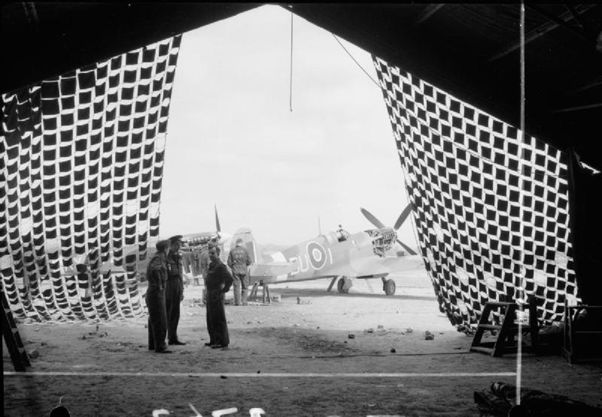
Arrived at RAF Bradwell Bay
29/12/44
Departed RAF Bradwell Bay
27/02/45
Aircraft Flown at Bradwell Bay
Spitfire LF lX
Squadron Code NN
Just after Christmas 2 Czech squadrons moved into Bradwell Bay. 310 had moved from RAF North Weald. The orb states their opinion of RAF Bradwell Bay:
Living conditions at BRADWELL BAY were found to be less convenient on the whole than at NORTH WEALD, the camp being widely dispersed and distances great. The Officers are billeted together with those of 313 Squadron in Down Hall, and the accommodation for the N.C.O. Pilots is somewhat cramped, but the Station and personnel show themselves anxious to help in every way, and it is satisfactory to see the Czech Wing united again.
310 Squadrons role was to escort bombers on Ramrod raids which were Short range sorties to attack ground targets carried out by bombers. The other point of these raids was to draw up German Fighters to hopefully shoot down and enhance air superiority.
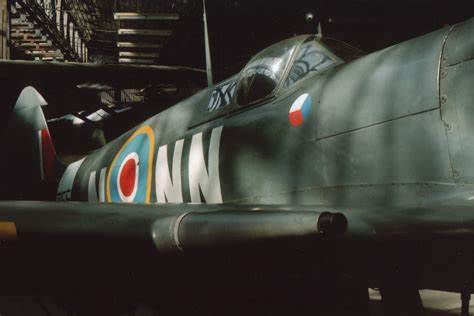
Arrived at RAF Bradwell Bay
29/12/1944
Departed RAF Bradwell Bay
27/02/1945
Aircraft Flown at Bradwell Bay
Spitfire lX
Squadron Code RY
Also arriving from North Weald just after Christmas. 313 Squadron were similar in their role to 310 and made up the Czech wing who were based at RAF Bradwell Bay for 3 months, all 3 squadrons leaving on 27th February 1945.
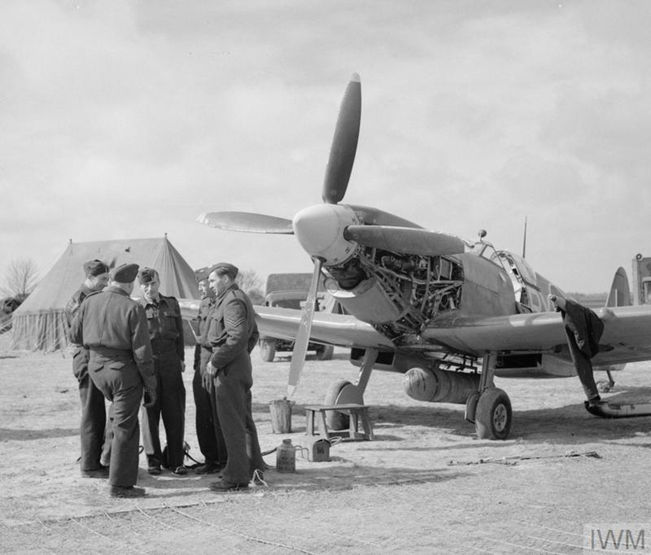
© IWM (CH 12860)
Arrived at RAF Bradwell Bay
01/03/1945
Departed RAF Bradwell Bay
17/05/1945
Aircraft Flown at Bradwell Bay
Mosquito xxx
Squadron Code DZ
One of the last wartime squadrons to arrive at RAF Bradwell Bay, staying until just over a week after Victory in Europe Day on 8th May.
Their role at Bradwell bay was flying as bomber support and occasional Ranger patrols. Most of the operations were uneventful as the war was in its final stages.
VE Day was suitably celebrated by the squadron and the whole station had a Victory Parade and a party in the evening.
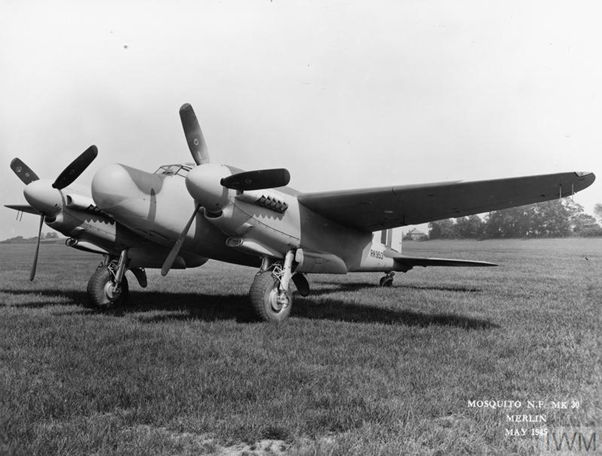
© IWM ATP 13735B
Arrived at RAF Bradwell Bay
16/03/1945
Departed RAF Bradwell Bay
15/06/1945
Aircraft Flown at Bradwell Bay
Mosquito xxx
Squadron Code RX
A squadron of the RAAF (Australian) was the last operational squadron to move into RAF Bradwell Bay before the end of the war. There was only about 7 weeks to go before the end, although of course this wasn’t known at the time.
The squadron’s initial reaction to RAF Bradwell Bay was that it was very dispersed with many requisitioned homes being used for accommodation, unfortunately transport around the base was hampered by a shortage of bicycles.
The squadron was busy with operation patrols mostly over the continent. 456 Squadron was disbanded on 15th June at RAF Bradwell Bay, having just lost their squadron Commander in an aviation accident.

© IWM (CH 10328)
Arrived at RAF Bradwell Bay
15/06/1945
Departed RAF Bradwell Bay
10/09/1945
Aircraft Flown at Bradwell Bay
Tempest V
Squadron Code KZ
Arriving at RAF Bradwell Bay 5 weeks after the war in Europe had ended. The squadron was formed at Croydon as an Anti-Aircraft Co-Operation Flight, in November 1941. One of its roles was target towing. Its tenure at Bradwell Bay was quite short leaving Bradwell Bay to go to West Malling and was disbanded there in June 1946.
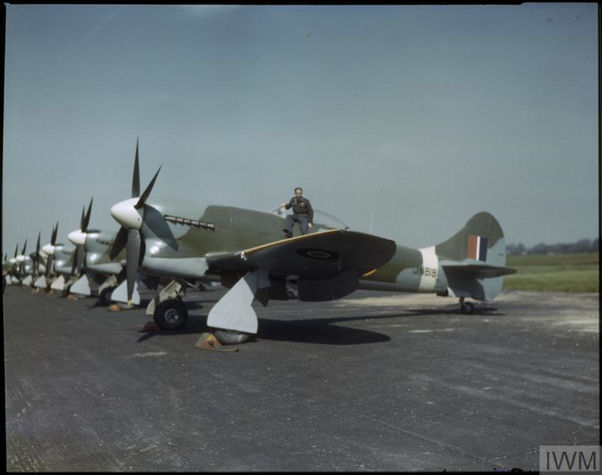
© IWM (COL 750)
Arrived at RAF Bradwell Bay
14/07/1945
Departed RAF Bradwell Bay
10/08/1945
Aircraft Flown at Bradwell Bay
Mosquito Vl
Squadron Code ZK
25 Squadrons short visit to RAF Bradwell Bay had to attend a 1-month course at No 2 A.P.S. This was 2 Armament Practice School which had just been formed at RAF Bradwell Bay, which was ideal as it had the Dengie Firing and Bombing Range under its remit. Having completed the course on 10th August the squadron returned to its base at RAF Castle Camps,
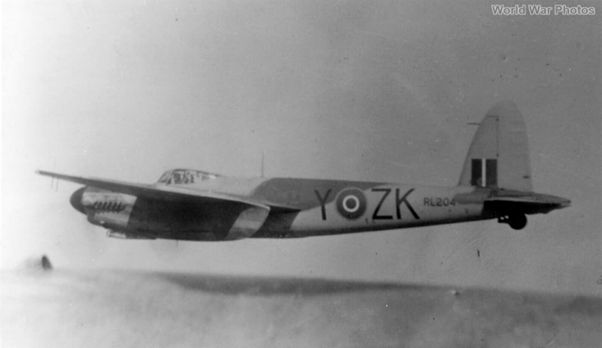
Arrived at RAF Bradwell Bay
13/08/1945
Departed RAF Bradwell Bay
07/09/1945
Aircraft Flown at Bradwell Bay
Mustang lV
Squadron Code QV
Another squadron coming to Bradwell Bay post war to attend a course with 2 A.P.S. for a month. In 1940, the current Station Commander Wing Com Geoffrey Dalton Stephenson had been 19 Squadron Commander. He was taken prisoner after being shot down on the beaches of Dunkirk, spending the rest of the war as a POW.
The squadron left Bradwell Bay following their course for RAF Molesworth.
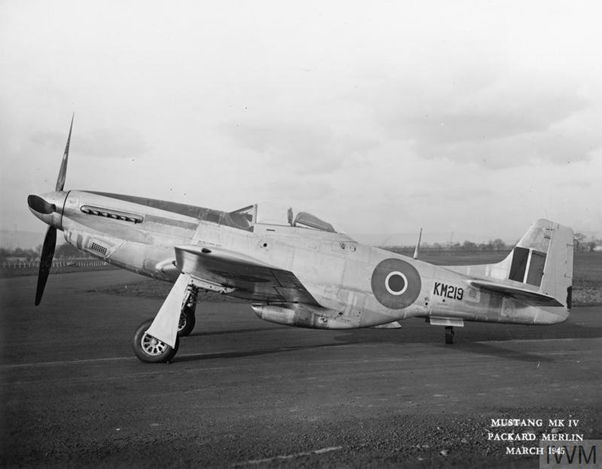
© IWM (ATP 13617C)
Arrived at RAF Bradwell Bay
13/08/1945
Departed RAF Bradwell Bay
07/09/1945
Aircraft Flown at Bradwell Bay
Mosquito xxx
Squadron Code VY
Yet another customer for 2 A.P.S. course. The officers were housed in the Officers mess in Down Hall. 2 Days after arriving at Bradwell Bay the Prime Minister announced that the Japanese had signed their surrender and now the war was completely over.
Leaving Bradwell Bay on 7th September 85 squadron and flew to Castle Camps.

© IWM (ATP 11264D)
Arrived at RAF Bradwell Bay
09/10/1945
Departed RAF Bradwell Bay
17/11/1945
Aircraft Flown at Bradwell Bay
Mustang lll
Squadron Code WC
The last squadron to attend 2 A.P.S. at Bradwell Bay. 309 (Polish) squadron. Flying Mustang lll’s on the course, unfortunately one of the aircraft broke up whilst in a dive on the range. The pilot, SGT S. SWIECICKI, was killed and was buried at Brookwood Military Cemetery.
The squadron departed from RAF Bradwell Bay on 17th November to go to RAF Coltishall.
